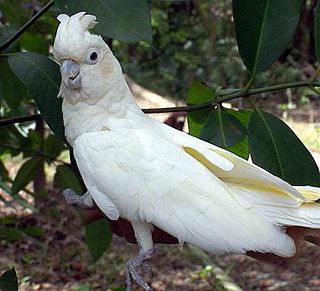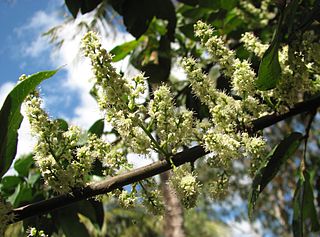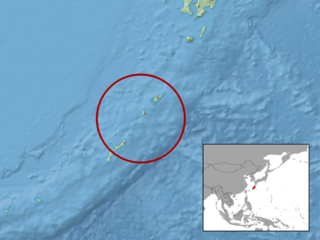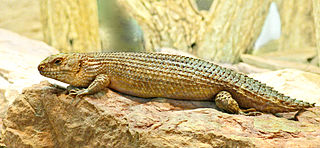
The red-vented cockatoo, also known as the Philippine cockatoo and locally katala, abukay, agay or kalangay, is a species of cockatoo. It is endemic to the Philippines though pressured by various environmental degradation and illegal pet trades, the population of the Philippine cockatoo is somehow growing owing to Katala Organization.It is roughly the size and shape of the Tanimbar corella, but is easily distinguished by the red feathers around the vent. It is threatened by habitat loss and the cage-bird trade.

Morelia is a genus of large snakes in the family Pythonidae found in Indonesia, New Guinea, and throughout Australia. Currently, up to eight species are recognized.

Stokes's sea snake is a large species of sea snake in the family Elapidae. It is sometimes placed in its own genus Astrotia. The species is endemic to tropical Indo-Pacific oceanic waters.

Guioa is a genus of about 78 rainforest tree species known to science, which constitute part of the plant family Sapindaceae. They have a wide distribution, ranging from throughout Malesia, in Burma, Cambodia, Vietnam, Thailand, Malay Peninsula, Borneo, Sumatra, Philippines, Java, Flores, Timor, Sulawesi, Moluccas, New Guinea, further southwards through the east coast of Queensland and New South Wales, Australia and further eastwards to the Pacific Islands, including Tonga, New Caledonia, Fiji and Samoa.

The Malayan civet, also known as the Malay civet and Oriental civet, is a viverrid native to the Malay Peninsula and the islands of Sumatra, Bangka, Borneo, the Riau Archipelago, and the Philippines. It is listed as "Least Concern" by IUCN as it is a relatively widely distributed, appears to be tolerant of degraded habitats, and occurs in a number of protected areas.
Plasmodium circularis is a parasite of the genus Plasmodium subgenus Sauramoeba.

A species that is extinct in the wild (EW) is one that has been categorized by the International Union for Conservation of Nature as known only by living members kept in captivity or as a naturalized population outside its historic range due to massive habitat loss.
The angulate pipistrelle, also known as the New Guinea pipistrelle, is a species of vesper bat found in Papua New Guinea and the Solomon Islands.

The Yanbaru whiskered bat(Myotis yanbarensis) is a species of vesper bat in the genus Myotis.

Juania australis, the Chonta palm, is a species of flowering plant in the family Arecaceae, the only species in the genus Juania. It is a solitary trunked palm tree which is endemic to the Juan Fernández Islands archipelago in the southeast Pacific Ocean west of Chile.

Satakentia liukiuensis, is a species of palm tree. They are endemic to Ishigaki Island and Iriomote Island in the Yaeyama Islands, the south-westernmost of the Ryukyu Islands, Japan. It is the only species in the genus Satakentia.

The Bounty shag, also known as the Bounty Island shag, is a species of cormorant of the family Phalacrocoracidae. They are found only on the tiny and remote Subantarctic Bounty Islands, 670 km southeast of New Zealand. Its natural habitats are open seas and rocky shores. In 2005 618 individuals were counted and the population seems to have remained stable since.

Arctostaphylos catalinae, known by the common name Santa Catalina Island manzanita, is a species of manzanita native to Southern California.
Hernandia stokesii is a species of plant in the Hernandiaceae family. It is found in French Polynesia and the Pitcairn Islands.
Ixora stokesii is a species of flowering plant in the family Rubiaceae. It is endemic to the island Rapa-Iti in French Polynesia.
Myoporum stokesii is a plant in the figwort family, Scrophulariaceae and is endemic to the island of Raivavae in French Polynesia. It is similar to the two other members of its genus on the island, Myoporum rapense and Myoporum rimatarense although the former has serrated leaves and the latter has wider leaves and differently shaped fruits.
The false oranges are a group of flowering plants in the Citrus genus, within the family, Rutaceae. They are endemic to New Caledonia.
The Lake Baikal mountain vole or Olkhon mountain vole is a species of rodent in the family Cricetidae. It is found principally on the Olkhon and Ogoi islands on Lake Baikal, in southern Siberia. While it was originally described as a species, Pavlinov and Rossolimo reassigned it as a subspecies of A. tuvinicus in 1987 before reinstating it as a species in 1998.

The small white-winged flying fox is a species of megabat in the family Pteropodidae. It is known from Mindoro Island, in the Philippines. Only 13 specimens have ever been found; one in 1998 and the others in 2006.

Egernia stokesii is a gregarious species of lizard of the Scincidae family. This diurnal species is endemic to Australia, and is also known as the Gidgee skink, spiny-tailed skink, Stokes's skink and Stokes's egernia. The species forms stable, long-term social aggregations, much like the social groups seen in mammalian and avian species. This characteristic is rarely found in the Squamata order, but is widespread within the Australian subfamily of Egerniinae skinks. Populations of E. stokesii are widely distributed, but fragmented, and occur in semi-arid environments. There are three recognised subspecies. The conservation status for the species is listed as least concern, however, one subspecies is listed as endangered.













